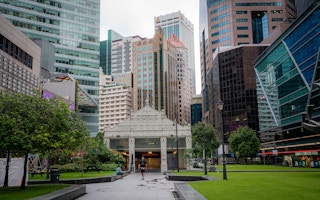Infection prevention remains at the forefront of everyone’s minds as Singapore starts to ease restrictions of the circuit breaker, the local name given to the lockdown to contain the Covid-19 outbreak. With a heightened awareness of health and safety in the city-state, businesses are considering ways to improve environmental sanitation standards beyond the pandemic.
As Sars-CoV-2 can survive on plastic and stainless steel for two to three days, the two tiers of environmental sanitation—disinfection and protection—are equally important, said Charn Bakhda, managing director of Singapore-based environmental solutions provider Big Red.
For a thorough disinfection of spaces against deadly viruses, bacteria and mould, Big Red’s solution is an aerosolised fog disinfectant named BR Strike, with an efficacy of “6 log kill”, or a 99.9999 per cent reduction of pathogens.
Echoing the need for frequent disinfection even after the virus has been eradicated, Leong Hoe Nam, an infectious diseases expert at Mount Elizabeth Novena Hospital, said, “You never know where the virus lurks. It can stay in the environment for a while, anyone can touch it and pick up the infection.”
Covid-19 is passed around through droplets produced by coughing, sneezing, or talking. The novel coronavirus is more infectious than the Severe Acute Respiratory Syndrome (SARS) outbreak that Singapore experienced in 2003, leading to a greater number of cases.
BR Strike uses binary ionization technology that only relies on one active ingredient that is effective against coronaviruses—low percentage hydrogen peroxide. The disinfectant has a rapid application and turnaround time, is non-corrosive, and is safe for electronic equipment.
“
“You never know where the virus lurks. It can stay in the environment for a while, anyone can touch it and pick up the infection.”
Leong Hoe Nam, infectious diseases expert, Mount Elizabeth Novena Hospital
Binary ionization technology was developed in conjunction with the US Defence Advanced Research Projects Agency (DARPA) to defend against biological and chemical agents in response to the 2001 anthrax attacks. One week after the September 11 terrorist attacks, letters containing deadly anthrax spores were mailed to several media companies and congressional offices, killing five people and infecting 17 others.
The Environmental Protection Agency (EPA)-registered disinfectant is currently being used around the world to decontaminate personal protective equipment for reuse due to the global shortage.
BR Strike works by nebulising a liquid solution of low-percentage hydrogen into a fine aerosol mist, which then passes under pressure through a cold plasma arc. The result is fine aerosol droplets of hydrogen peroxide with an added ionic charge that enables the droplets to be physically and magnetically attracted to the surfaces of the virus itself.
“The ionised hydrogen peroxide can cover every nook and corner. Even if you miss a surface while spraying, the gas spreads around and mingles with all surfaces, followed by a thorough surface wipe-down.” explained Bakhda.
Compared to other disinfectants like bleach that may damage surfaces or affect users, BR Strike reacts on contact and does not leave any residue or trace in the environment.
“It goes, kills its target and evaporates into oxygen and water within five to ten minutes,” said Bakhda. The sprayed area is safe to enter after the evaporation of the ionised hydrogen peroxyl.
However, the NEA has warned that disinfectant application by handheld misters and electrostatic sprayers are not adequate on their own and should only be used to supplement wipe-downs.
Post-pandemic environmental sanitation measures
As Singapore heads towards a new post-Covid normal later this year, facilities managers will take on a greater responsibility to upkeep the cleanliness and hygiene of their premises. Frequent cleaning, disinfecting and increased accountability are part of the amendment of the Environmental Public Health Act by NEA to introduce mandatory baseline cleaning standards.
While proactive disinfection is important, prevention is always better than cure, said Mark Yeo, chief operating officer of property management at global real estate services company CBRE. “It is still highly encouraged that cleaning is done at regular intervals—say twice or thrice a day.”
Moving forward, Yeo foresees that many buildings will explore the implementation of touchless features to decrease contact within public spaces and surfaces in the building.
“For instance, using electronic payment such as PayNow instead of cash payment, using QR codes to access buildings’ turnstiles and passenger lifts. There could be the removal of common touch-points, like restrooms with automated doors, or automated light switches and thermostats,” Yeo said.
Additionally, to improve indoor air quality, property owners can consider installing ultraviolet lighting within their air handling units to remove airborne bacteria and germs, and having North-South-facing openings for increased natural ventilation.
Cautious optimism for the future
The Singapore economy is now expected to shrink between 4 and 7 per cent this year, the third official downgrade in economic forecasts in 2020.
Although the global pandemic has brought about unprecedented costs and disruptions to businesses, Desmond Sim, head of research of CBRE remains positive for the future. “While there have been disruptions in the short term, where businesses are finding the optimal way in their operations, we are cautiously optimistic that Singapore will be the first port of call for investors, capital flows and multinationals seeking safe havens and talent.”
Prompt action and a higher standard of environmental sanitation by government and industry to protect their employees, customers, and supply chains will remain top priority for Singapore’s safe reopening.











